By Andrew Laker
For centuries, children of the Laker clan were born and raised on a single diminutive patch of earth in Angelbeck, a small village south of Löningen in the southern reaches of the Duchy of Oldenburg. Under the feudal system, the eldest son traditionally inherited the farm from his father if he was willing to do homage, and when he too became too old to work, his oldest son would take over. These men died in the same house they were born in, and the cycle continued as true as the seasons. It was not uncommon for a farm to remain in one family for many generations.
Between the years 1473 (the oldest-known potential connection to the Laker name) and 1815 (when the property was transferred to a daughter), evidence supports the theory that there was usually never more than one Laker family residing in the village at one time. If a hypothetical family tree is stitched together using several historic registers, as many as twelve (and likely many more) generations of Laker descendants called this one little speck of dirt their home. Unfortunately, the location of something so important in the fabric of the Laker family’s history has been quite adept at remaining a secret.
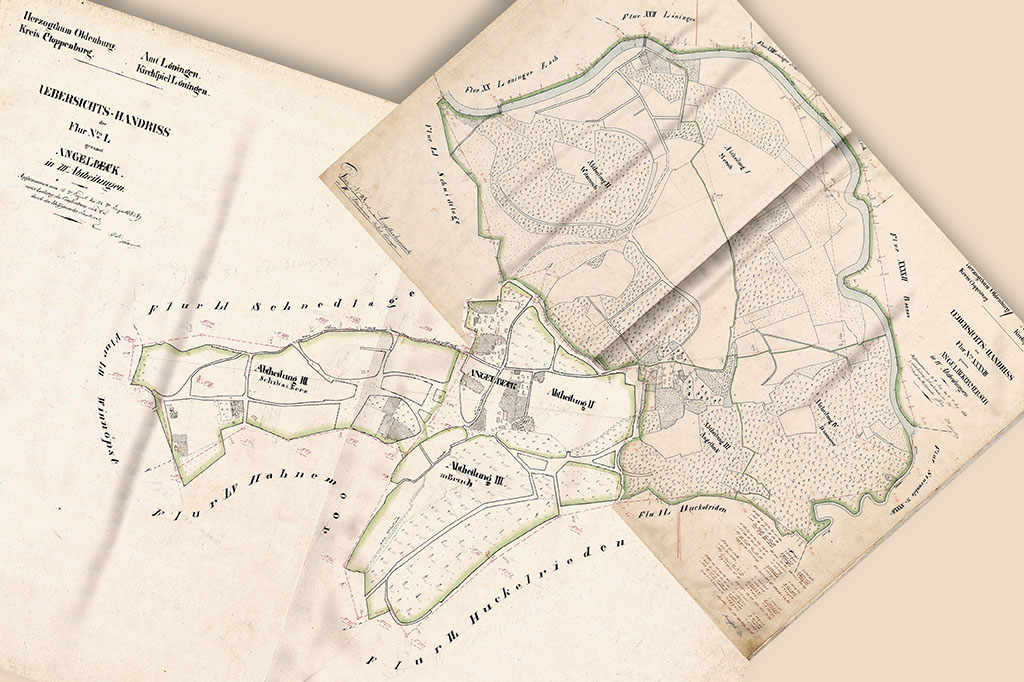
Sweeping changes were made when Napoleon conquered the Duchy of Oldenburg in 1810 and abolished the feudal system. Oldenburg regained control in 1814, however a result of French rule meant land could be conveyed to others with greater ease. Johan Meinert Laker did not waste much time in taking the opportunity to relinquish his property. On August 22, 1815, the small Laker farm and its belongings were turned over to Johan Meinert Laker’s future son-in-law, Lambert Feltman, who would marry the youngest daughter Maria Elisabeth Laker on September 5, 1815.
Documents have been found detailing this property transfer, but sadly no house number or land dimensions were provided to help pinpoint the exact location. Lambert Feltman had at least two sons and two daughters with his wife Maria Elisabeth before his untimely death on January 27, 1826, at age 42. Her father, Johan Meinert Laker, continued living with his daughter until his death a year later on January 31, 1827 (it had been part of the property transfer agreement that the young couple would care for him in old age and illness and “bring him to earth in befitting style”).
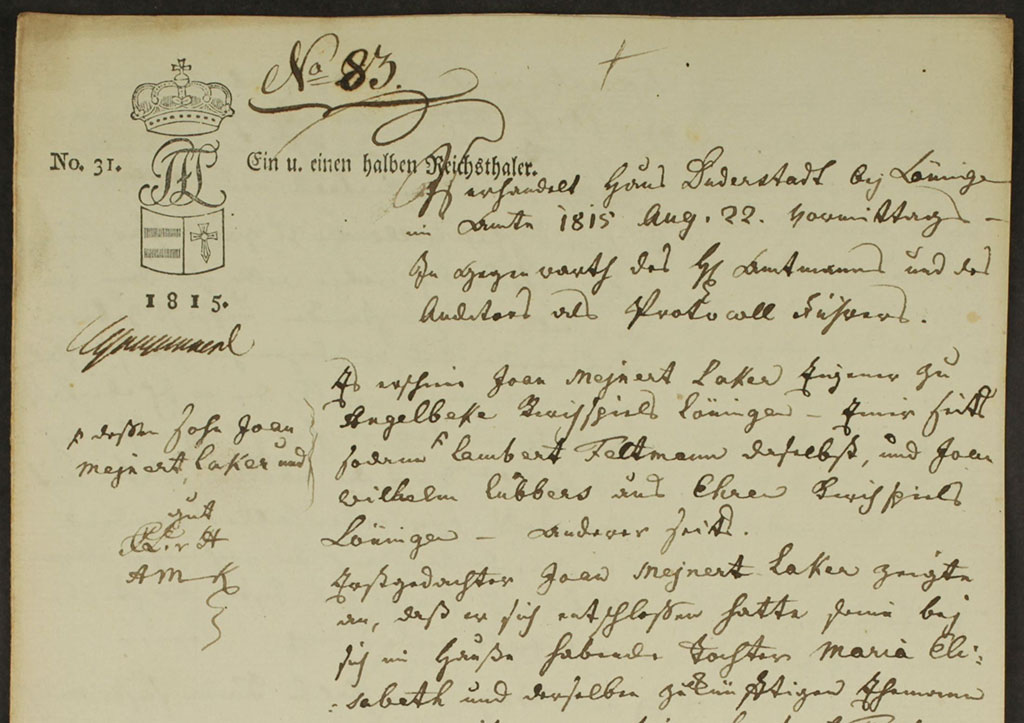
The widow Feltman later married Johan Gerd (Gerhard) Willoh of Huckelrieden on February 20, 1827, and together they had at least two sons and a daughter. According to church records, the widow and her second husband continued to live in Angelbeck.
In 1838 the region was surveyed for a reorganization of property taxes in the Grand Duchy of Oldenburg, and detailed land maps were drawn for the first time. Parcel owners were also shown on the map, and often two names were provided (the previous owner‘s name was stricken when updated). One such map of Angelbeck shows a pair of properties not far from one another and both bearing the name Johan Gerd Willoh. Another property with a house on it to the west of these plots also contains the name Johan Gerhard Willoh. Adding considerable confusion, church records show there was more than one man named Johan Gerd Willoh living in Angelbeck at this time. Bear with me, because this is about to get mighty confusing.
Too many Willohs
(Now with color-coded charts for easier reading!)
Johan Gerd Willoh, the second husband of Maria Elisabeth Laker, was given the same name as his father, and he gave his first-born son this name as well. This man is distinguished in his birth and death records with the name Johan Gerd Christopher Willoh, but his second middle name does not appear that way in his marriage or in the baptism records of his children.
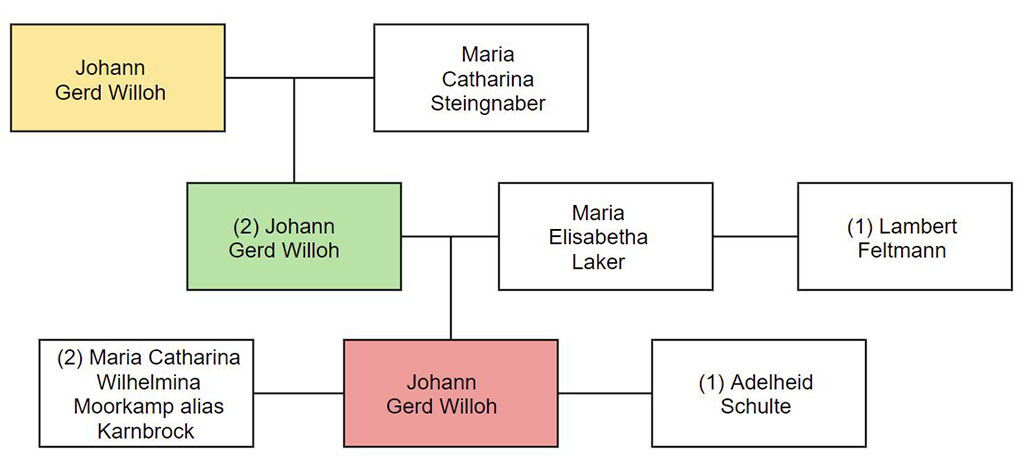
Another man, Johan Gerd Willoh, husband of Anna Maria Diekgers, was also named after his father, who was actually a Meyer but took his wife’s surname. Johan Gerd Willoh and Anna Maria Diekgers also used the name Gerd for their children – twice: Hermann Gerhard Willoh and Johann Gerd Heinrich Willoh. This man was consistently listed in church records as a Zeller or the owner of a large farm.
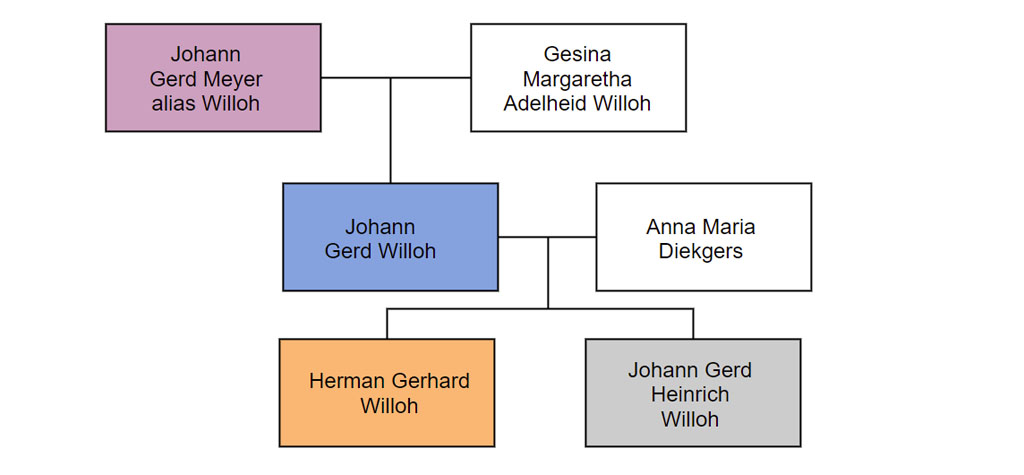
Also living in Angelbeck during this time was yet another Johann Gerd Willoh who was born in Evenkamp, the son of Johan Bernd Willoh and Anna Margaretha Lampen. Slightly less confounding is the presence of a man in Angelbeck named Johann Gerhard Willen, whose name often resembles the others in the faded and sometimes messy church records.
The maps of 1838 are also peppered with the names of more Willoh men – Heinrich, Bernard and others – sometimes written in the obsolete German Gothic script. Still another Johan Gerd Willoh was living in Augustenfeld, a village also in the Löningen parish.
By my count, that’s at least nine people named Johan Gerhard Willoh all living in roughly the same place and time period, with plenty of additional confusion thrown in for good measure.
Shit.
Process of elimination
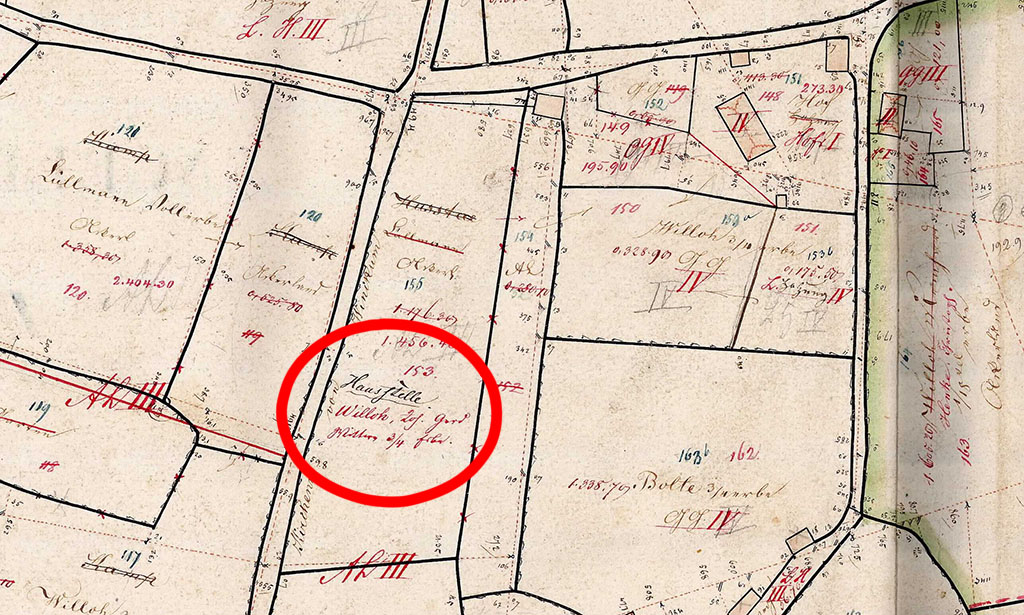
The map detail above shows a plot in Angelbeck listed under the name Johan Gerhard Willoh. An online search showed that it was owned in 2012 by Herr Bernhard Willoh of Gänhauk 4, 49624 Löningen, Germany. Figuring this was more than just a coincidence, I contacted Mr. Willoh for this study and learned from our correspondence that, although he was related to the Laker family, he was not a descendant of Maria Elisabeth Laker and Johan Gerd Christopher Willoh. His great-great-grandfather was actually the Zeller Johan Gerd Willoh, the husband of Anna Maria Diekgers. It should be noted that I’ve taken the liberty to assume his great-grandfather is the one listed on the map, although it is possible that is not the case given the existence of multiple men with the same name. But let’s just say for now that’s our guy.
The name Lullman is stricken from the plot on the map, which means the previous owner was not a Feltman or a Laker. In other words, this also points to the conclusion that this is not the original Laker property.
Another small property due north of it on the map – too small to list the owner’s name directly on the plot – has the name Johan Gerd Willoh written in the margin and corresponds to #143. It is not known if this property was also owned by Bernhard Willoh’s great-great-grandfather, or if maybe the owner was the second husband of Maria Elisabeth Laker, or perhaps one of the others.

This is a possible candidate for the Laker land, but there is not much to go on. The small size is in keeping with a 1700 document reproduced in Löningen in Vergangenheit und Gegenwart (Löningen Past and Present) which lists the Laker dwelling in Angelbeck as “Brinkkot.” Brinkkothner or Brinkkotter broken down means an inhabitant of a cottage (kotten) near the brink (a border, edge or margin), however deeper meaning of this word has been disputed due to the differences in word definitions from village to village.
Plattdeutsches Wörterbuch des kurkölnischen Sauerlandes, a Low German dictionary, defines brink as a bank, small mountain (or hill), swamp or source area. Kotten is defined as a Heuerling’s (hired hand) small house or home of a small-scale farmer.
The Laker property transfer documents found at Staatsarchiv Oldenburg in Beurkundungen vor dem Amt Löningen (Best. 76-22 Akz. 142 Nr. 708) detail Meinert Laker’s belongings, which include twelve sheep and at least three milk cows. Upon viewing the satellite imagery for the land in question, it does not seem possible to accommodate this much livestock, but it is not known if these same property lines had been in place before the map was drawn or if perhaps the livestock was kept off-site.
I jotted this one down as a maybe, but I didn’t have much of a feeling for it.
Getting warmer
There are, however, more properties of interest in the village. One of these is yet another parcel owned by Johan Gerhard Willoh just west of the others, and there is a small house on it. Nearby, there is a plot with the name “Lacker” stricken from it. Above it is scrawled the word (or name?) Heidland, and below is the name Johan Gerhard Holters, the man who had apparently purchased the land. Heidland translates to moorland in English, which may have meant it was a tract of uncultivated land.
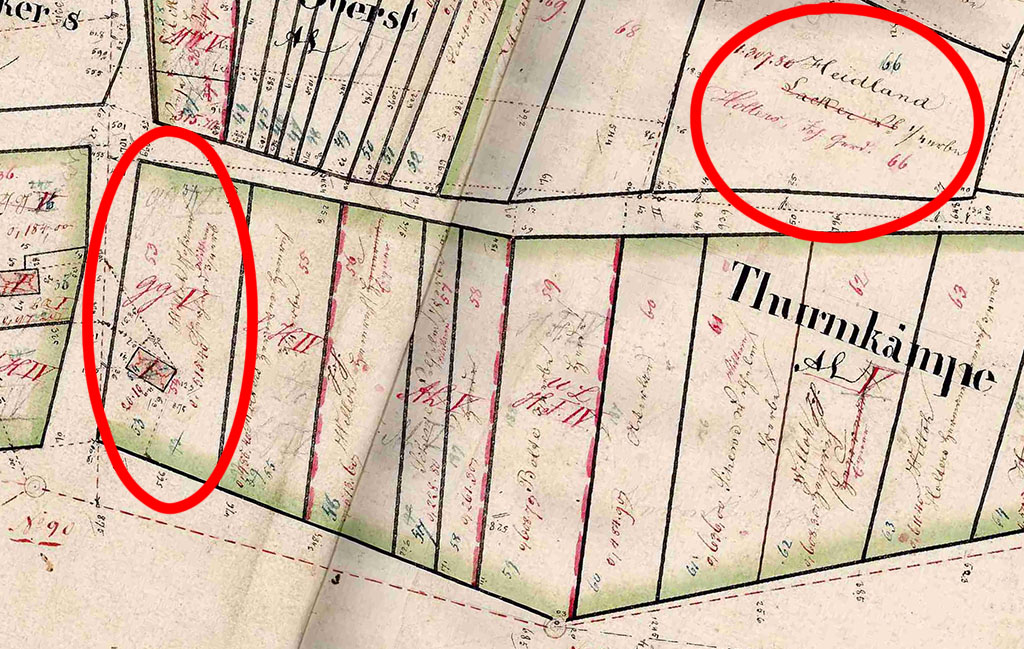
Much like the other two properties, the physical distance between these plots is minimal – in this case, less than 200 meters. The size of the homestead property appears ample enough to hold livestock, however one would suspect the presence of a barn or at least a shed. If the nearby farmland was indeed formerly owned by the Lakers, it certainly adds favor to the possibility of the slightly larger Willoh homestead as having once belonged to the Lakers as well. Both residential properties are near the bordering village Schnetlage, which is where on Aug. 31, 1577, Angelbeck resident Lake Johanne gave a meadow back to the church. This parcel is farther from the main residential areas of the village, which better fits the “Brinkkotter” distinction.
There may have occasionally been confusion about village boundaries by the priests – the 1830 baptism record of Johan Gerhard Christopher Willoh’s son, Johan Heribert Willoh, initially listed the family from Schnetlage, but it had been crossed out and replaced with Angelbeck.

Peter Sieve from the Offizialatsarchiv Vechta was able to shed some light on this.
“Angelbeck was a peasantry in the parish of Löningen.” he said. “Within this peasantry there were the districts Angelbeck, Schnetlage and Huckelrieden.” (I promptly forgot that important clue, and I would kick myself years later for doing so.)
Lastly, just a few properties to the west of this residence are the familiar surnames Post and Lubbers, which the Laker family married into. These facts all lent strong support to the theory that this property was the original Laker land, but there was still no definitive proof. The present-day address for this plot is Angelbecker Feld 3, 49624 Löningen.
A death in the Laker house
Despite having been transferred in 1815 to someone not bearing the Laker surname, the home apparently continued to be known as the Laker house. According to a document found at the Staatsarchiv Oldenburg, Heinrich Anton Winkler, a hired hand, died in the Laker house in Angelbeck on August 20, 1847. He was very ill and did not have time to make his testament. Father Anton Riesselmann of St. Vitus Church tried to find seven persons who could be witnesses of Heinrich Anton Winkler telling them his last will, which was that his wife should receive everything if he died. It seems that there had to be exactly seven persons present. One of those persons was Johan Gerhard Willoh – he was asked to come because there were only six.

These witnesses were required to tell what happened on August 20th, and a number of interesting facts surfaced from their testimonies, as translated by Oldenburg-based researcher Irmi Gegner-Suenkler:
1) Willoh said that a man called Theodor Kramer came to his home and asked him to be present. We also learn some personal (albeit slightly inaccurate) information from his testimony: “My name is Johan Gerd Willoh. I was born and am living in Angelbeck, 48 years old, Catholic, am not related to the deceased or his widow and had no interest in the matter.” St. Vitus church records show he was in fact 49 years old, having been baptized Dec. 7, 1797, in the neighboring village of Huckelrieden (part of the Angelbeck peasantry) – but that’s close enough.

2) Hermann Anton Winkler, father of Heinrich Anton Winkler, who was present as well when his son died, tells that he himself asked to send for “Mr. Willoh at Laker’s.”
3) Heinrich Theodor Kramer, 15 years old, tells that he was sent for J.G. Willoh “in Laker’s Heuer” (a smaller house belonging to a farm) and asked him to come because one person was missing. Gegner-Suenkler believes Kramer lived next to this place.
4) Maria Elisabeth Lampe tells that Father Riesselmann sent someone to “the neighbor Willoh” and asked him to come.
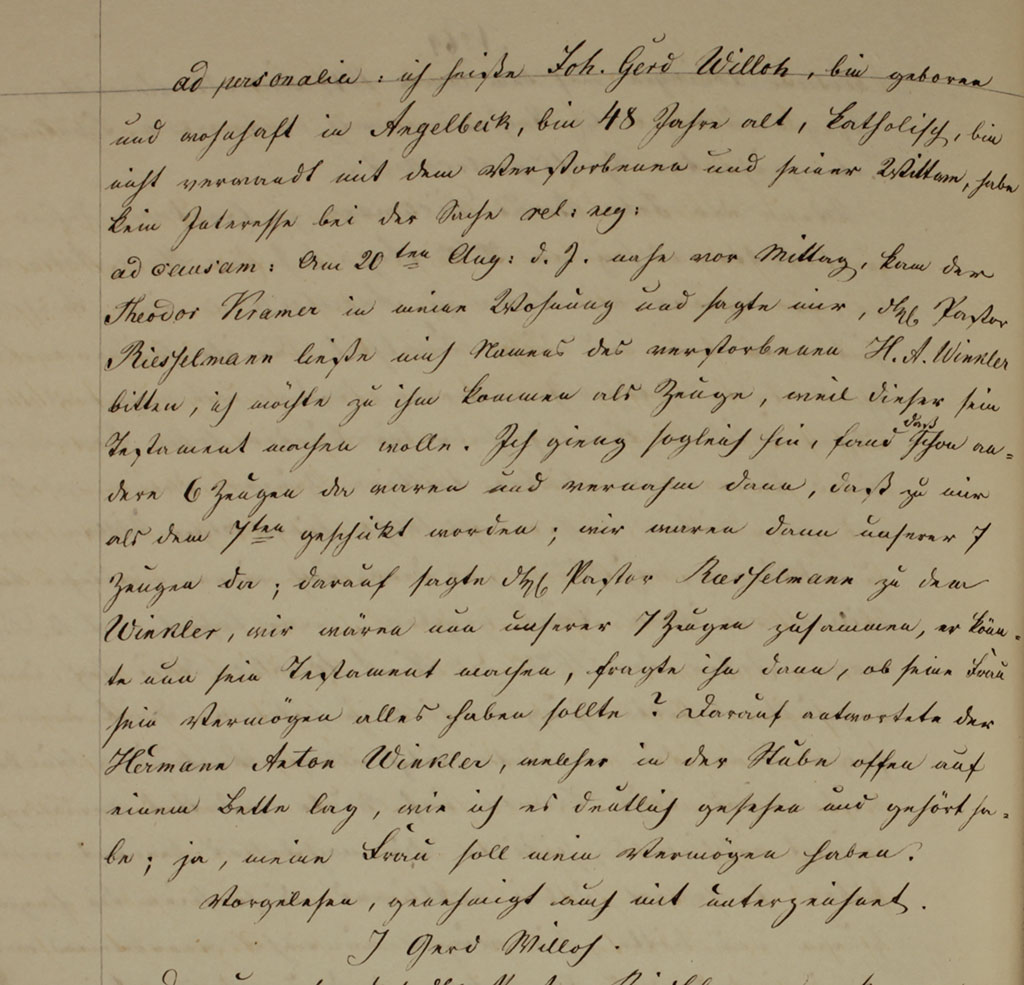
All of these findings brought me incredibly close to locating the property, however the 1838 maps did not appear to show properties owned by anyone named Kramer or Lampe (at least not near the properties in question). Also, there were numerous properties with homes on the Angelbeck maps where no name was present. I was disheartened when I realized any one of these could have been where the Lakers called home. Perhaps, I thought, the only way to trace the property would be to learn what happened to the children of Maria Elisabeth Laker and her two husbands and which one of them may have received the farm (I’ll come back to that later).
Little is known about the children, but we know that some of them emigrated to America. Word was received in Löningen in 1870 that Johann Meinard Lambert Feltman, oldest son of Lambert Feltman and Maria Elisabeth Laker, had died in “St. Louis in America.” He left behind a wife, Margaretha (born Eberle), and a family.
Heribert Willoh, second son of Johan Gerd Christopher Willoh and Maria Elisabeth Laker, was listed in an 1872 directory of St. Louis living with a person named Margaretha Feldmann. This was likely the widow of his half-brother Johann Meinard Lambert Feltman. Another online genealogy has a Herbert Willoh from Oldenburg, Germany, born in about 1830 and living in St. Louis, which is also a likely match. There was also a transfer of guardianship of a child named Louis Meyer between Heribert Willoh and John M. Feldman in 1867 in St. Louis Probate Court, but it is unclear who this child was.
Finally, we know Johannes Lambertus Feltmann, the second son of Lambert Feltman and Maria Elisabeth Laker, married Maria Elisabeth Holrah in Löningen in 1848. It is not presently known if the couple stayed in Germany, but a Lambert Feltman was listed as a godparent in the 1861 baptism record of Johann Gerhard Willoh’s first son Lambert Joseph Willoh, which is undoubtedly him. The record is difficult to read, but it appears Lambert Feltmann’s village was written down as Huckelrieden.

Maria Elisabeth Laker and Lambert Feltman also had two daughters, Helena Adelheid b. 24 Nov 1821, and Maria Adelheid (birthdate unknown but born in Angelbeck). Nothing else is known about them. Maria Elisabeth Laker had a daughter with Johan Gerd Christopher Willoh as well, Maria Elisabeth b. 9 Oct 1834. Maria Elisabeth Willoh was found in the 1860 U.S. Census living in St. Louis with a Feldman family. She was listed as a step-sister.
It should be noted that by 1899, no Feltman or Feldman was listed in a directory of Angelbeck, but five Willoh heads of household were called — two Zellers (large-scale farmers), one Heuerman (hired hand), one Zimmermann (carpenter) and one Eigner (farm owner). It is interesting that Johan Gerhard Christopher Willoh was occasionally listed in church records as an Eigner, including on his death record. Perhaps the Eigner in the directory, listed only as G. Willoh, was the man who inherited the ancestral Laker farm. If this is in fact the first-born son of Johan Gerhard Christopher Willoh and Maria Elisabeth Laker, born Dec. 9, 1827, and named (what else) Johann Gerhard Willoh, he would have been 72 years old in 1899. That is, of course, if he lived that long. (UPDATE: He didn’t.)
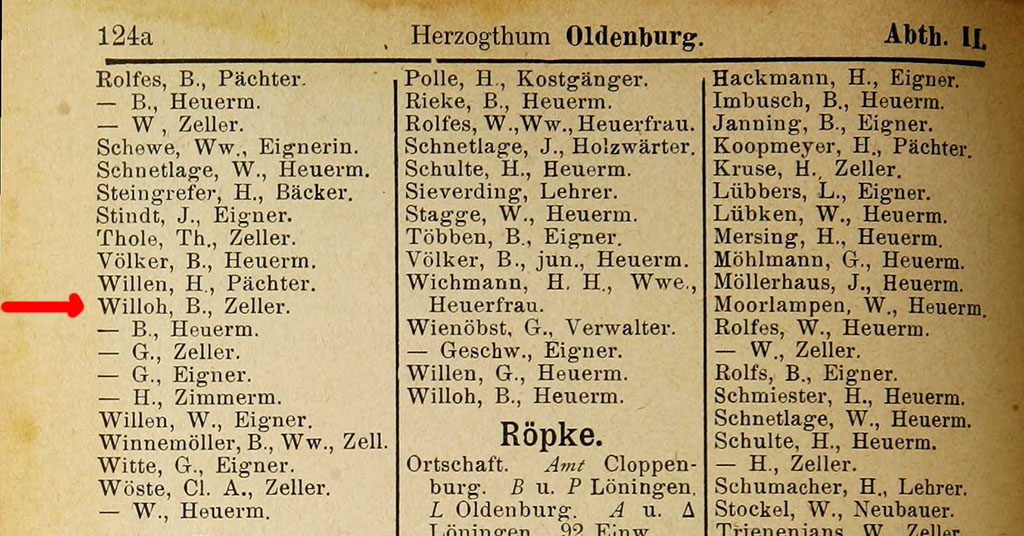
Johan Gerhard Christopher Willoh died on May 15, 1853, in Angelbeck at age 59, and Maria Elisabeth Laker died there as well on May 7, 1857, age 63. The zeller Johan Gerhard Willoh died on July 11, 1848, at age 72, and the Evenkamp-born Johan Gerhard Willoh died Nov. 8, 1860, age 57.
Taking another crack at it
I wrote the majority of the previous piece in 2012 and included it in The Laker History Book. I ended my research suggesting that the western plot in Angelbeck was probably the best candidate for being the original Laker homeland. I was never satisfied with coming so close to finding it and not being able to cross the finish line. I knew I needed to dig back into the Löningen church records, but it seemed to me a daunting task.
My findings had pointed to Johann Gerhard Willoh, oldest son of Maria Elisabeth Laker and Johan Gerhard Christopher Willoh, as the likely heir to the farm. I had begun to focus my attention on him, but there was never enough time to spend at the local Family History Center where the church microfilms were housed. A bit frustrated and needing to focus on other things, I stepped away from genealogy for several years.
When I took a peek at my long-neglected Ancestry.com account in 2021, I saw a message from a fellow Laker researcher who mentioned a website called Matricula. Curious, I checked it out. I was absolutely blown away to discover the entire Löningen church records had been digitized on the site with full free access to them. Suddenly I had time to browse the records at my leisure from the comfort of home.
I got to work.
It gets more complicated, if that’s possible
I picked up where I left off by researching the oldest son of Maria Elisabeth Laker and Johan Gerhard Christopher Willoh.
Johan Gerhard Willoh married Adelheid Schulte in 1860. They had three children, all of whom died young. To add to this sad fact, Adelheid died as well in the spring of 1866.
Johan remarried in the winter of 1867 to Maria Catharina Wilhelmina Moorkamp alias Karnbrock, a woman nearly twenty years his junior. Tragically, four of their five children had died by 1880, and Johan himself died in 1880 at age 52. The remaining child died at age 21 in 1896. This effectively marks the end of ownership of the original Laker property by someone in the family, at least as far as bloodlines go.
Johan‘s widow Maria married Johann Clemens Heinrich Brümmer from Röpke in 1881, and they continued to live in Angelbeck as evidenced by the birth records of their children Elisabeth (1882) and Clemens (1887).
I went back to the 1898 directory of Angelbeck upon which I had been previously fixated on the Willoh listings. Sure enough, Clemens Brummer was listed as an Eigner (owner). Also, for the first time, I noticed the small description under the Angelbeck heading, which translates as “Peasantry, consisting of the village of Angelbek, the village of Huckelrieden and houses in Schnetlage.” Peter Sieve had already told me that, but I hadn’t made much of that fact until seeing it again in this directory.
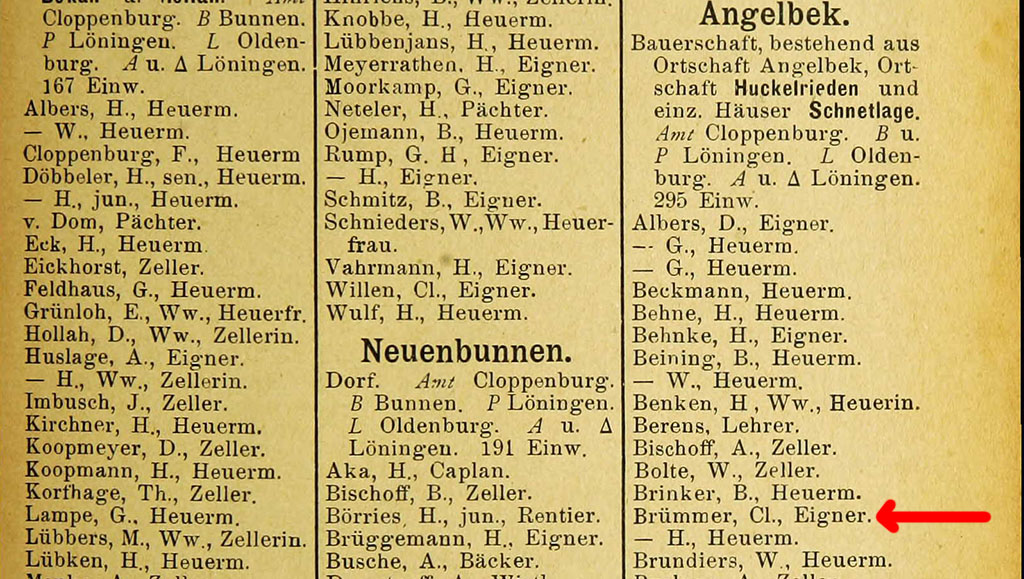
This was a great find, but unfortunately, the directory still didn’t list an address. I felt I was getting close, so I kept poring over the church records.
Johann Clemens Heinrich Brümmer died in 1917 at age 66, and his death record shows he was still living in Angelbeck at the time.

That is where the trail ended (temporarily) as the church death records on the Matricula website stop at 1929, and the widow apparently lived beyond that year since no death record was found. The junior Clemens Brümmer married Maria Catharina Johanna Schulte in 1910. Baptism records end at 1907 on the Matricula website, however, so we’re unable to tell from available church records if they had children and raised them in Angelbeck (I did find another clue elsewhere, which I’ll address).
Still, this gave me a broad window — nearly 40 years — to look for the Brümmer family in Angelbeck. One can assume the widow lived in Angelbeck for several years after her husband’s death, and I thought it would be quite possible that her son and his wife lived there as well.
I felt like I was closing in on solving this mystery, but I was not able to find another directory or map from this time period. I reached out to another researcher in Oldenburg, and I sent another message to Heinrich Prante who originally supplied me with the 1838 maps of Angelbeck.
Let me Google that for you
While waiting to hear back from these contacts, I decided to simply Google the Brümmer name in Angelbeck … and the first result from Das Telefonbuch made my jaw hit the floor.
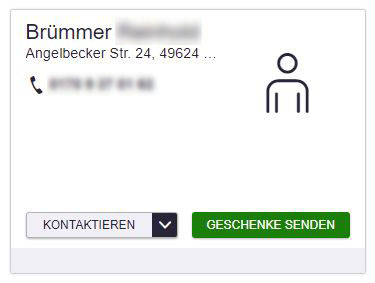
It couldn’t be, could it? I opened the address on Google Maps, and it all started to come together. The home was shown as being a short distance due west of Munzebrock’s Mersch, which I’ve often suspected may be the “lake” behind the Laker name.
First, a short detour about that: The word lake in middle low German roughly translates to Mersch in Low German and Marsch in high German, which both mean marsh.
Below is an excerpt from a Middle Low German dictionary showing the definition of lake and an approximate translation of it:
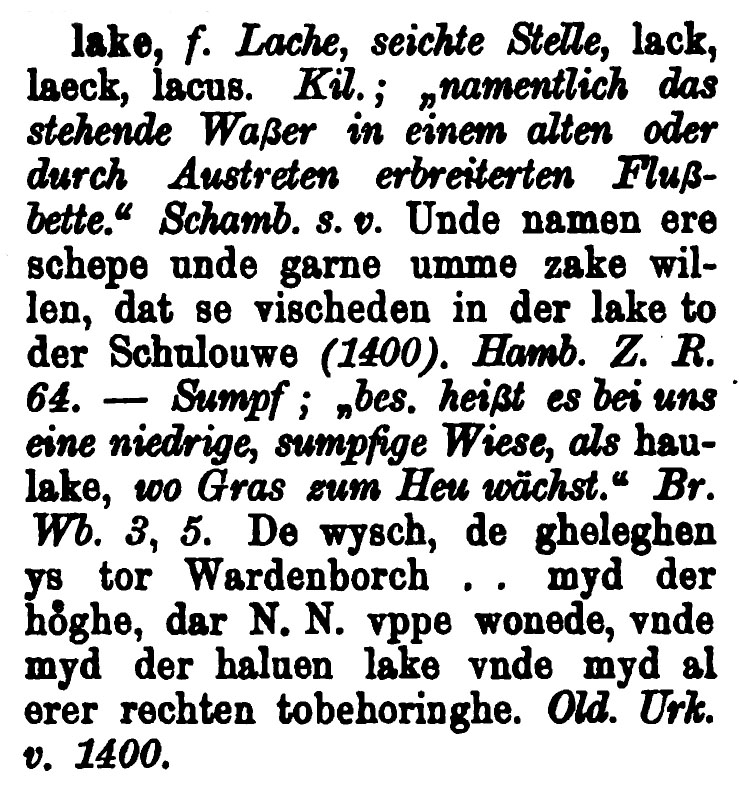
lake, f. Lache, shallow spot, lack, laeck, lacus. Kil. “specifically the standing water in an old or widened riverbed.” Schamb. s. v. Therefore, names of ships and fishing equipment are named after the lake for the purpose of fishing in the lake to the Schulouwe (1400). Hamb. Z. R. 64. Swamp; “especially it is called a low, marshy meadow, as haulake, where grass grows for hay.” Br. Wb. 3, 5. The meadow, which is located in Wardenborch with the height, where N. N. lived, and with the haluen lake and with all its rights. Old. Urk. v. 1400.
A haulake, literally a hay lake, can be further described as a kind of swamp land. The Middle Low German phrase “haluen lake” is associated with the term “lake,” but it’s not necessarily a body of water, but rather a saturated low-lying wetland.
As far as I could tell from records, Anton Munzebrock was a doctor from Löningen who apparently bought the “mersch,” however I could not find a name for it prior to that. It may have simply been part of the larger Angelbeckermersch floodplain shown on the old maps. Whatever the case, it wouldn’t be a bad guess to assume the Lake/Laker surname was given due to a long-ago resident’s proximity to this geographical feature. But that is another story.
I had also been suspicious that the Lakers may have not lived in Angelbeck the village at all, but instead resided in the neighboring village of Schnetlage which I now understand to be part of the Angelbeck peasantry. The clues were there all along, but I just hadn’t put the pieces together as I was unfamiliar with the difference between a village and a peasantry.
In addition to the occasional slip-ups by priests in the St. Vitus church books, there is also the curious mention of Schnetlage in 1577.
Peter Sieve, who works in the Offizialatsarchiv Vechta where the Löningen parish archive is kept, found an Aug. 31, 1577, parchment certificate that details Angelbeck resident Lake Johanne’s pledge of a meadow in the community of Schnetlage back to the church. It should be noted that during this time the Laker name had not yet taken on the “r” at the end of it, and surnames were generally written first, “facing” the given name.
An excerpt written in Low German reads as follows:
… darmit de vorgerurten wissche van Lake Johanne tho Angelbecke umme merklicher orsaken willenn ingeloseth undt also tho unser kerken tho Loningen behoiff unndt nutticheit ahngewanth hebben.
I used an artificial intelligence language model called ChatGPT to roughly translate:
Therefore, the aforementioned lands of Lake Johanne of Angelbeck for notable reasons have been granted and thus for the benefit and usefulness of our church in Loningen have been put to use.
Sieve explained that the councilors of St. Vitus pledged a meadow belonging to the church to Lutheran pastor Ptolemeus Langhorst (the church had been converted to the Lutheran faith following the Protestant Reformation, but then switched back to Catholocism during the Counter-Reformation). This field was used by the Ratleuten (asset managers) of the Church, and the document describes that it was being returned by Lake Johanne.
Although the circumstances are somewhat unclear, it is possible Lake Johanne simply did not need to use the communal land anymore, or perhaps it was a gift to the popular pastor who had come to Löningen just four years prior. In later years the community fell out of favor with pastor Langhorst who was described as a quarrelsome and contentious man (Löningen in Vergangenheit und Gegenwart, pp. 79-83).
I had recently been making a rough Photoshop composition merging various maps from Angelbeck and Schnetlage and wondered if Schnetlage held the key. I had wanted to ask Heinrich Prante about this years ago, but I felt I had already bothered him enough and told him my last request was indeed my last.
I wish I had inconvenienced him one last time. My email inbox showed that my most recent message to him bounced back as undeliverable. He was gone. I would have to find another way.
The satellite view on Google Maps, when cross-referenced with the Angelbeck maps of 1838, showed the Brümmer property slightly outside of the Angelbeck boundaries — right where Schnetlage was!
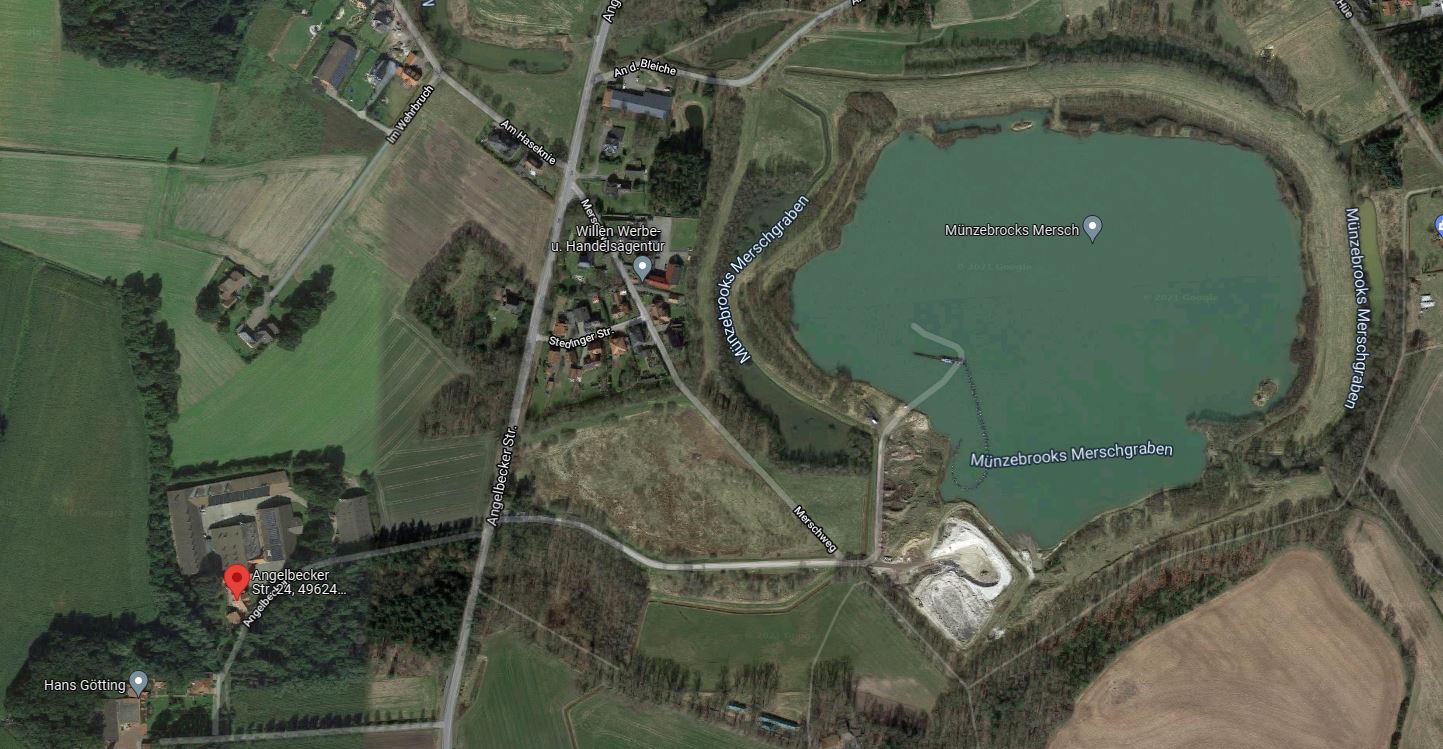
To be sure of this, I created a new composite map using a larger-scale map of Schnetlage and overlayed it on the satellite view, careful to match geographic markers. It’s amazing how many tracts of land retain their shape over the centuries. The location was most definitely within the borders of Schnetlage.
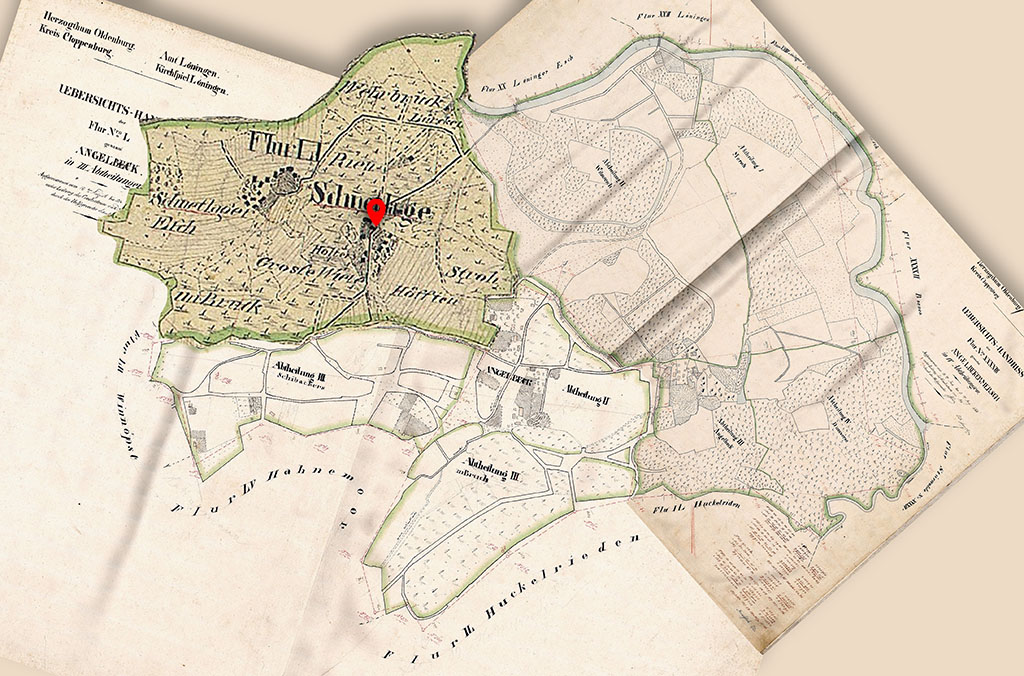
Several more buildings appeared on the property in the satellite image as well. I wondered what those were.
More frantic Googling on the address revealed that this was more than just a residence. It was also the address of Brümmer Schweinezucht GmbH — a working pig farm!
Brümmer Schweinezucht GmbH is located in Löningen, Niedersachsen, Germany and is part of the hog and pig farming industry. Brümmer Schweinezucht GmbH has 5 employees at this location and generates $1.13 million in sales (USD).
dnb.com/business-directory/company-profiles
I continued my search for the Brümmer name in Angelbeck on Ancestry.com, and a result returned from the database Germany, Military Killed in Action, 1939-1948.
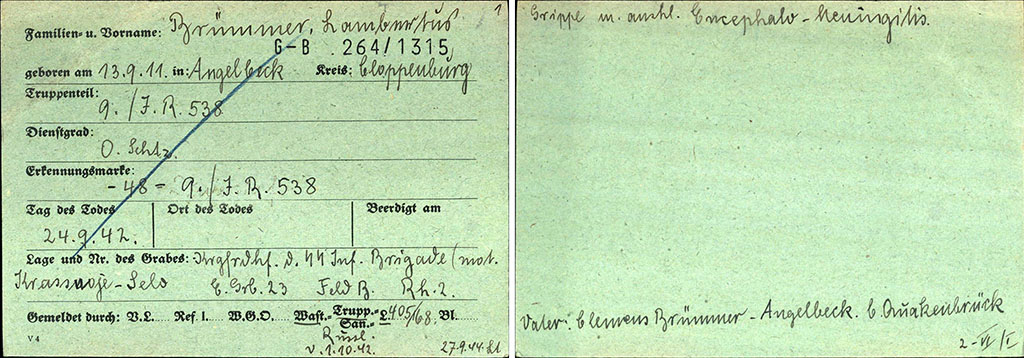
A death notification card from World War II listed 31-year-old infantryman Lambertus Brümmer from Angelbeck, the son of Clemens Brümmer, who died of sickness on September 24, 1942. This told me that the junior Clemens Brümmer did in fact live in Angelbeck following his marriage in 1910 and raised his family there. Another source on denkmalprojekt.com listed a second Brümmer from Angelbeck, Franz, who was likely a younger brother of Lambertus and who also died in the war in 1944. These findings, while tragic for the Brümmer family, brought me much closer to finding the missing piece of the puzzle. (Note: The denkmalprojekt website’s purpose is primarily for genealogy purposes, but also to act as a stark reminder and a “warning against the insanity of war.”)
Navigating German government bureaus
It turned out that Herr Prante who had sent me the 1838 Angelbeck maps had since either moved on or retired from his position at the Cloppenburg land registry, and the person on the receiving end of the general info email address I had written to responded that they did not have the map I was looking for. They pointed me instead to the state archives, which had changed names in a restructuring.
I was bounced around a few more times in my effort to locate the correct state and the right department.
At last, someone replied that they needed my mailing address to process my request, which I thought odd but provided. I once heard that Germans love rules (and I have to admit that I do as well).
And then … no answer. I was destined to wait a bit longer.
About a week later, I received the following email:

Dear Mr. Laker,
I found two historical maps of Schnetlage for you. The older map forms the basis of the younger one, which was changed with ongoing updates from 1861 to 1956.
The exact names of the maps are:
NLA OL Urkataster Best. 298 Z Nr. 9755 — (1838);
Flur Nr. 51 Schnetlage (“Schnedlage”), Gemeinde Loningen (Urkarte) Scale: 1: 3000
Surveyor / draftsman: Schulzen I / Schulzen IINLA OL Urkataster-Fortschreibung Best. 298 Z Nr. 9635 — (1838) 1861-1956;
Flur Nr.51 Schnetlage, Gemeinde Löningen (Reinkarte) Scale: 1: 3000
Surveyor / draftsman: Schulzen I / Schopen / Pestrup IIOn the basic map (a so-called “original map”) the farm of your ancestors is still marked with the owner’s name “Laker.” This name is no longer included on the update map (so-called “Reinkarte”).
I had scans made of both maps for you. You can find the invoice in the appendix.
After paying the amount, we will send you a link to download the image files.Kind regards,
Dr. Sven Mahmens
Niedersächsisches Landesarchiv Abteilung Oldenburg
You can imagine my excitement after pasting Dr. Mahmen’s message into Google Translate. It had at last confirmed my beliefs regarding the whereabouts of the original Laker farm. Or, at least, that’s what I was hoping. There was still that last piece of legwork needed to prove it once and for all. It was also nice to learn the precise location of these maps and finally have a name for them: Urkataster.
Urkataster means original cadastre, and a cadastral map is a comprehensive recording showing extent, value and ownership of land for taxation.
The Staatsarchiv Oldenburg, now known as Niedersächsisches Landesarchiv Abteilung Oldenburg, had made some updates to their online presence since last I checked several years ago. Unfortunately, paying an invoice online was not one of those updates. It looked like I would need to mail a physical payment to Germany.
I went to the local post office to purchase an international money order.
“We don’t do those anymore,” the clerk said matter of factly. “Are you sure you’re not being scammed?” Ah, the U.S. Post Office at its finest.
It had been so long since I’d sent a payment to Germany, and I couldn’t remember how to go about it anymore. I later realized I had previously used a cashier’s check from my bank, but oh well. Instead of overcomplicating things, I decided to hit the easy button and reached out to a researcher in Germany who I had connected with previously.
It would be more expensive this way, but it would be faster. And besides, she’d be able to pull additional maps from adjacent villages of Huckelrieden, Winkum and Sturwold — maps I suspected would contain additional relatives’ farms. (Unfortunately, they did not, but at least now I know.)
The dots, connected at last
In all of my rapid-fire emails sent to various bureaus, it appears I struck gold twice. While I was waiting to hear back from a researcher, I woke up on October 12, 2021, to the following message from Christian Möller at Landesamt für Geoinformation und Landesvermessung Niedersachsen (LGLN) – Regionaldirektion Oldenburg-Cloppenburg:
Dear Mr. Laker,
Your information, as far as I could understand, is all correct. Today’s Hof Brümmer at Angelbecker Straße 24 is their former family seat. It is interesting, however, that in the first official map from 1838 your family name “Laker” was still written down. It seems that your ancestors still lived in this house even though you were no longer the owners. Your name is no longer in the land registers, which provide information about ownership. Johann Gerd Willoh is already entered here. A section of this map is attached. If you would like to have this complete map as a file, I would charge you a one-off fee of € 25. This map covers the entire village of Schnedlage in 1838.
I hope I could help. If you have any further questions, please do not hesitate to contact me.
Kind regards
Christian Möller
The attachment Herr Möller included was the final piece of the puzzle, at long last. I did some quick math and sat back in my chair when I realized it had been 175 years since my Laker ancestors had left their homeland. It occurred to me that I might be the first Laker in America to know the location of the original ancestral seat since then. This small patch of earth where dozens of Laker families lived, gathered, played, worked and died was no longer lost to time. The search for this land, which often felt like a fruitless effort, had finally paid off. I couldn’t wait to share the news with my family.
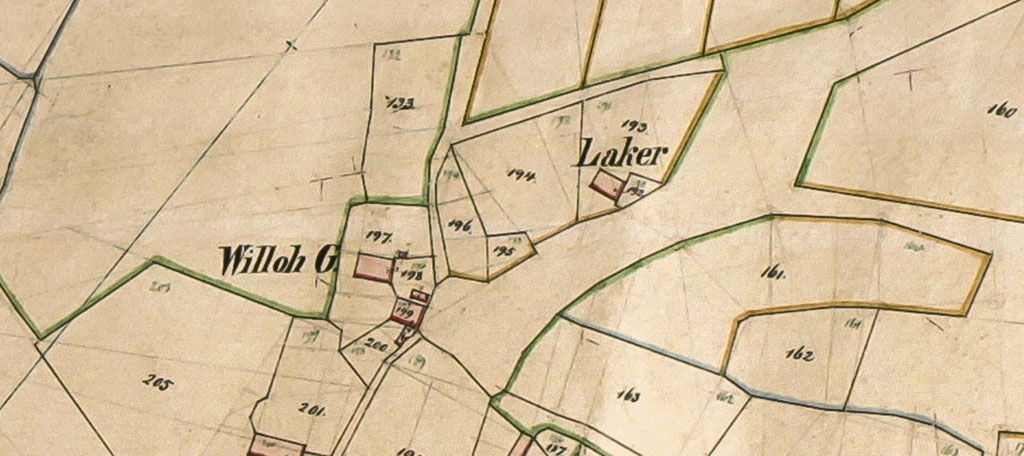
It is interesting to see both Willoh and Laker names on the 1838 map. Meinard Laker had died by 1827, so the fact that the Laker name still appears on the map despite no Laker actually owning land there (according to Herr Möller), well … that’s another mystery. It does align with the previously-discussed documents detailing the untimely death of Heinrich Anton Winkler in which “Laker’s Heuer” is mentioned. It seems the two properties both indeed comprised the original Laker land.
Thanks to the researcher I hired, the “Reinkarte” update map arrived in my inbox a week later showing that both the Willoh and Laker names were no longer included on the document. The small “x” markings apparently show that the structures on the Willoh portion of the property were razed at some point between 1861 when the map was created and 1956 when it was retired. These maps, when overlayed upon modern satellite imagery, show that the structure on the eastern Laker property (312/192) approximates the location of today’s Brümmer home and farm buildings.
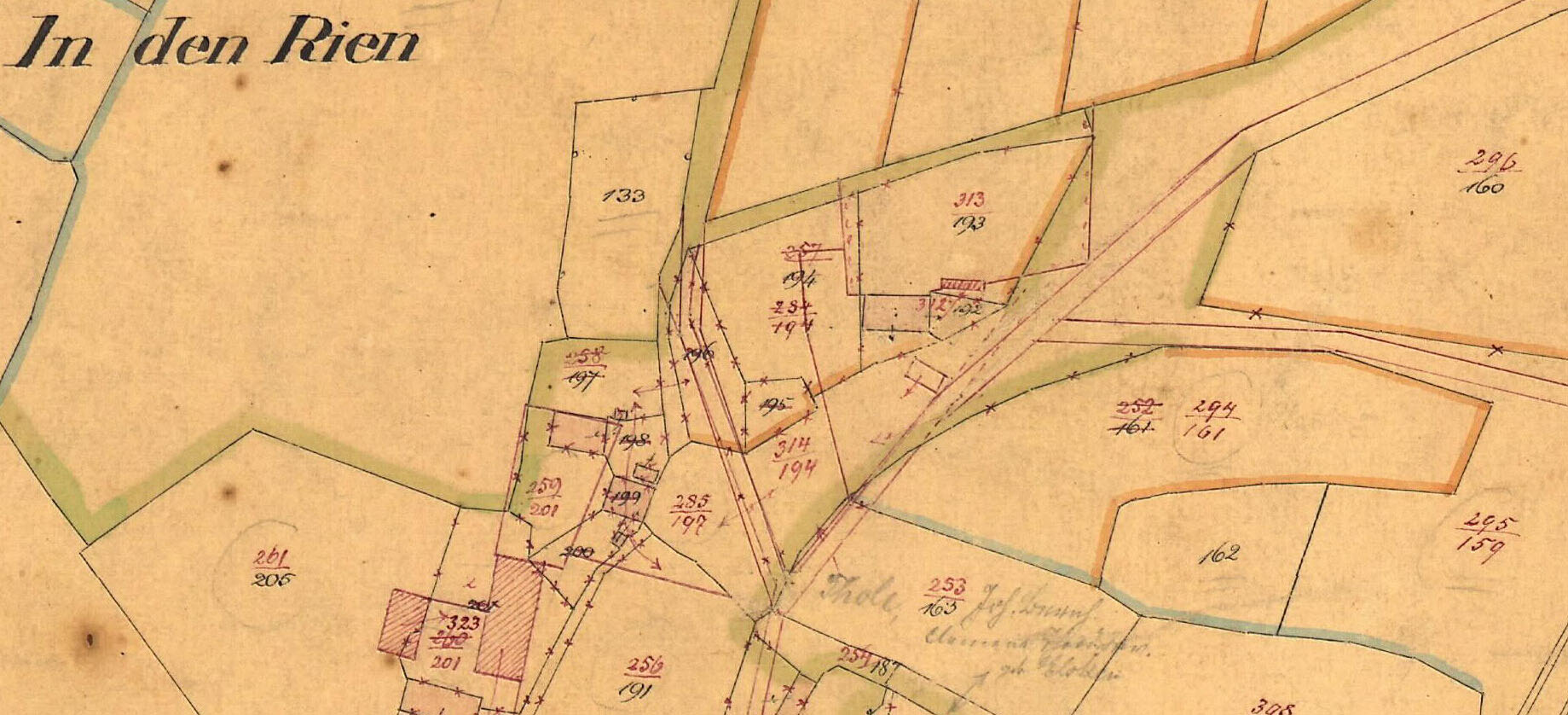
Lots of Lakers on Laker Lots
While I was studying the lineage of the Laker family in the Löningen parish, I made note of nearly every Laker entered into the St. Vitus Löningen church books. Eventually, many branches grew from the main Laker tree, and my genealogy software swelled to include hundreds and hundreds of names. The older church book entries often lacked critical context in birth, marriage and death records, and at times took a bit of investigative work to match and “plug in” individuals I came across in hopes of untangling these sprawling documents. In genealogy, sometimes it is just as important to know who someone isn’t as it is to know who someone is.
A happy side effect of all of that research now allows me to paint a better picture of what was happening around 1838 when the Urkataster map was first drawn.
Anna Margaretha Elisabeth Laker, daughter of Joannes Laker and Wendelina Adelheidis Freericks, and oldest sister of Johan Herman Meinard Laker, actually ended up with the Laker farm before her brother. She married in 1756 when Johan Herman Meinard was just nine years old, and she and her husband Herman Theodore “Dirck” Fieck continued living in Angelbeck where they raised their family.
Joannes Laker, father of Anna Margaretha Elisabeth (Laker) Fieck and Meinard Laker, continued living in the ancestral home with his daughter and her husband until he died in 1761. After his death, we know that Herman Fieck began going by his wife’s maiden name as evidenced in the 3 Oct. 1763 baptism record of his daughter Anna Maria Adelheidis. Ironically, it would take yet another baptism before the priest learned how to spell his surname Fieck which was more familiar in the nearby town of Essen. The priest had creative spellings for Laker as well.
| BIRTH DATE | CHILD | PARENTS | PLACE |
| 7 Aug 1757 | Joannes Wilhelmus | Joannes Theodorus Ficke, Anna Margaretha Laeker | Angelbeck |
| 15 May 1760 | Anna Marg. Aleid | Herm Dirck Fikes, Anna Marg. Laeker | Angelbeck |
| (10 Jun 1761 Death of Joannes Laker) | |||
| 3 Oct 1763 | Anna Maria Adelheidis | Hermannus Theodorus Laeker cond. Ficus, Anna Marg. Laeker | Angelbeck |
| 9 Sep 1769 | Anna Margaretha Elisabetha | Hermannus Theodorus Laaker natus Fieck, Anna Margaretha Laaker | Angelbeck |
| 29 Jul 1773 | Joannes Hermannus Bernardus | Hermannus Theodorus Laaker, Fieck condictus, Anna Maria Laaker | Angelbeck |
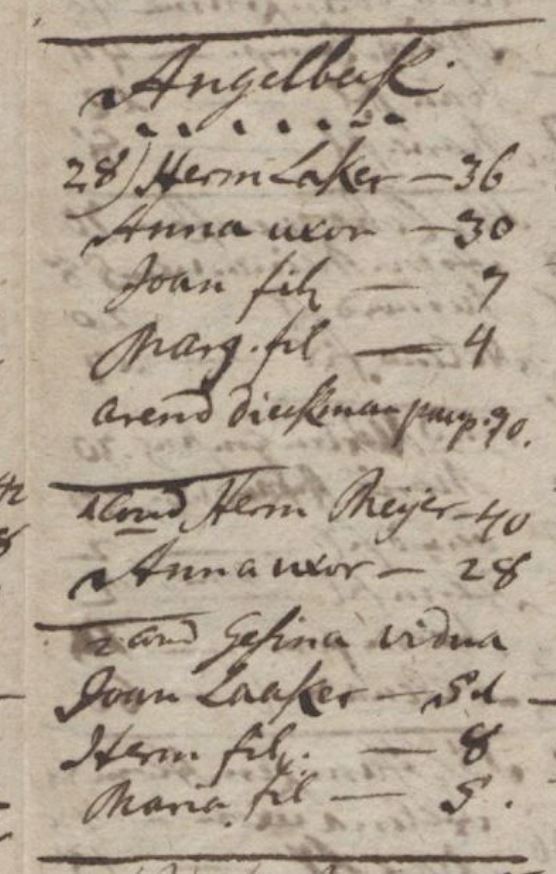
Further proof of this arrangement exists in the 1766 Löningen Status Animarum, a “state of souls” parish registry.
In Angelbeck, the Herm Laker family is listed with wife Anna and two children, Joan (Johan) – 7, and Marg. – 4. It should be noted that the ages listed in these registers were often incorrect, so it is assumed those counting the individuals were making their best guesses as needed.
The following were also listed at this location:
- Bernd Dieckman – 70
- Herm Meijer – 40
- his wife Anna – 28
- Gesina (widow of Joan Laaker) – 51
- her son Herm. – 8
- her daughter Maria – 5
It is not presently clear if or how the Dieckman and Meijer residents were related.
It is also not known where Johan Herman Meinard Laker was living at the time. He would have been about 19.
One can only imagine the problem it may have caused when Johan Herman Meinard not only survived his childhood (a hard thing to do back then), but also took a wife himself in 1779 making him the rightful heir to the Laker farm.
Without documentation to provide more clues, it is hard to say exactly what may have transpired. There may have been an amicable agreement where Meinard was able to build a home on the settlement while his sister’s family continued residing there. If true, then both the Willoh and Laker properties shown on the map combined made up the original Laker land. The easternmost home on the map was quite possibly the original dwelling, but it cannot be proved with any certainty.
Whatever the case, the residential situation on the farm continued to evolve. Herman Bernard Laker, son of Maria Gesina Windhus Laker and half-brother of Herman Meinard Laker, had likely lived at the farm all of his life. He married Maria Catherina Post in 1781, and they continued living in Angelbeck for several years. For unknown reasons, the family moved to Löningen between 1790 and 1793. By that time, Herman Meinard Laker and wife Anna Helena Hillen had two healthy boys. Perhaps Herman Bernard, only 8 years younger than his half-brother, had given up hope that he would inherit the farm and moved away. Another possibility might be that his family was growing and that they simply needed more space. Maria Gesina Windhus, third wife of Johan Laker, died in 1798 at the age of 82. Her son Herman Bernard Laker died in Löningen in 1804 at age 48.
Herman Fieck died in 1781, and his wife Anna continued living in Angelbeck until her death in 1808. So why would the map makers have listed the Laker name on the 1838 map? St. Vitus church records might hold the clue to this as well.
The youngest son of Herman Fieck and Anna Laker, Johan Herman Bernard Laker, married Maria Catherine Knobbe on 28 Apr 1809 — a little over a year after his mother’s death. He and Maria Catherine had at least six children together, and all were born in Angelbeck. The family most likely continued living on the Laker land, perhaps paying rent to Gerhard Willoh. Johan Herman Bernard Laker died in 1833, and little is known about the rest of the family after that.
The widow and her children may have still been living in Angelbeck when the map was drawn in 1838, which could explain why the old Laker homestead was still listed on the map despite no Laker actually owning the property. No death records have been found for her or for the rest of the family, so the widow may have remarried and relocated her family or moved to live with an adult child in another village or town.
Her oldest daughter Anna Margaretha Elisabeth Laker married Hermann Plate in St. Vitus Church on 10 Nov 1842. The bride’s parents are listed in the marriage record as being from Angelbeck. The Plate family’s first child Catharina was born 27 Dec 1842, and although they are shown living in Löningen, Anna’s sister Catharina was named the godmother, and her homeplace was listed as Angelbeck. Therefore it is probably a safe bet that there was still a Laker family living on the Schnetlage property when the 1838 cadastral maps were created. Keeping the Laker name on the map may have simply been out of respect, but we’ll probably never know for sure.

On a side note, Catharine Plate shows up in the 1860 census in St. Louis, Missouri, living with the family of John Meinard Feltman. Next to her name is written the word “adopted.”
Once the Laker family had left Angelbeck at last — somewhere between 1842 and 1861 — the property would have been inhabited solely by the Willohs until 1880, and then by the Brümmers from 1881 to the present.
Making contact
I wrote a letter to the Brümmer family in Angelbeck and told them of my findings, and I included a copy of The Laker History Book. I later connected with a family member on Facebook. The family was very excited to learn more about the history of their farm, which has now been in their name for more than 140 years.
They knew of the Willoh farm but had never heard the Laker name attached to their land. They provided some recent history and sent some wonderful photos.
We have 1,200 sows, 5,500 piglets on our farm in Angelbeck and 4,000 slaughter pigs from other people a few kilometers away. We work on 145 hektar fields and plant wheat, corn and barley. We only have 30 hektar in ownership and the rest in lease. So the whole farm was not so big and wealthy the last generations, but my dad made it much bigger and built the stables.
The Brümmers came from Röpke, also a small village 3 kilometers from here. Some say they broke down their farm there and brought it to Angelbeck and rebuilt it here. Perhaps not first at our place, but about 200 meters away.
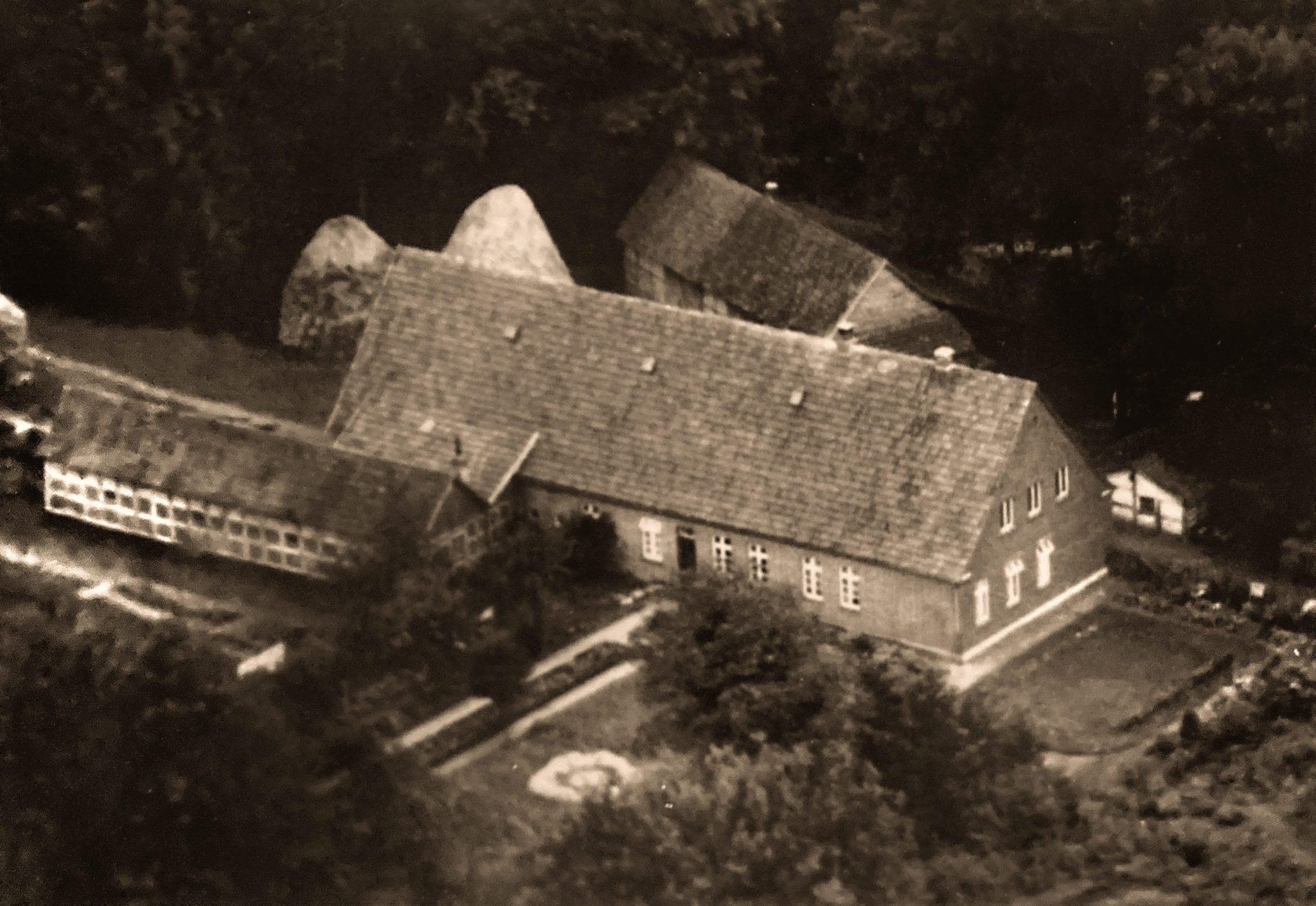
This old picture is of our farm. I asked my dad which year it is, but it must be nearly 1930. The main house is today still there, but now for the sows. In 1930 the people, cows, horses and other animals lived there together.
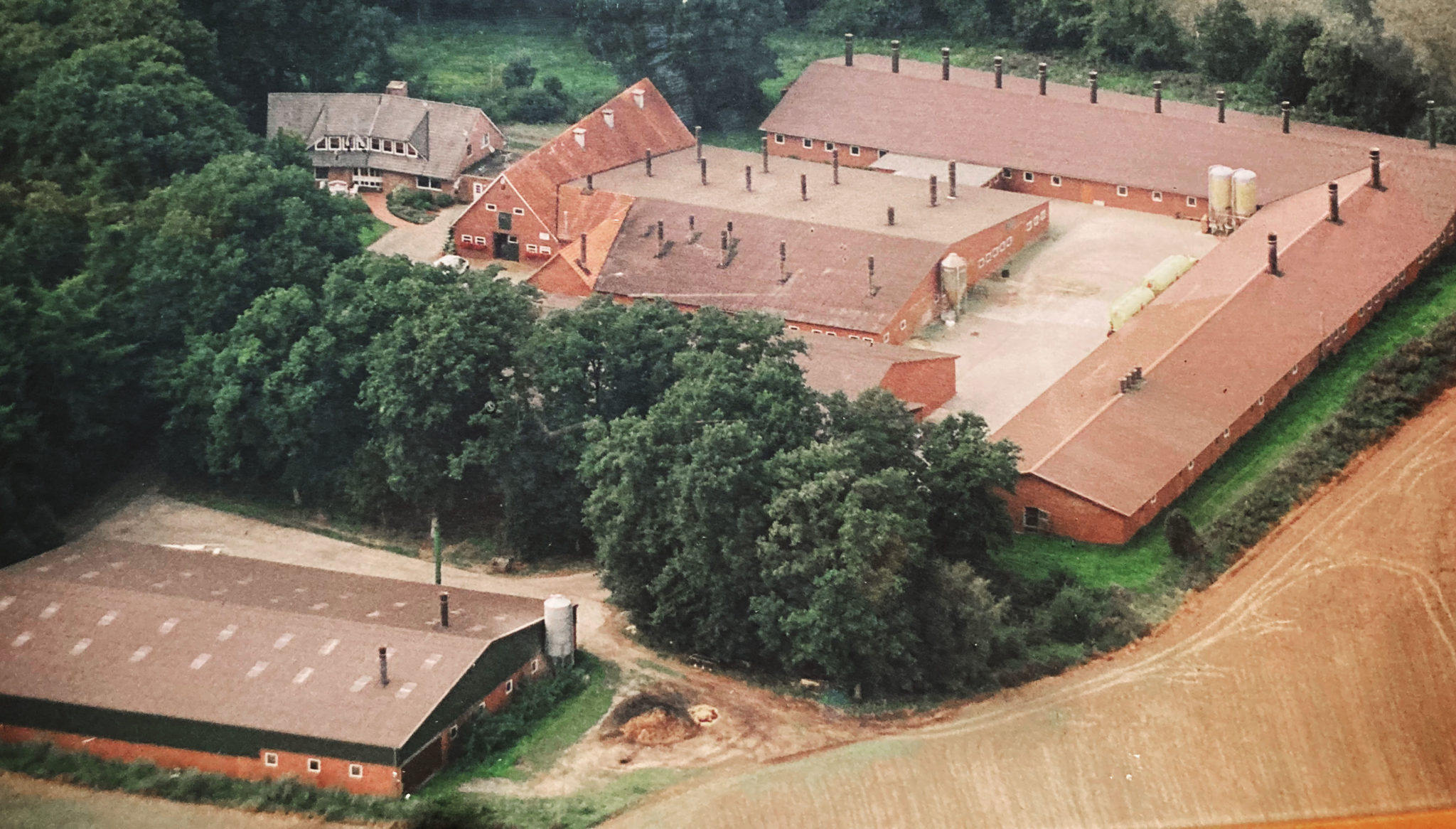
This is our farm from 2008 I think. You can see the original house with the new living house at the top left built in 1979 by my parents and all the stables for the pigs!
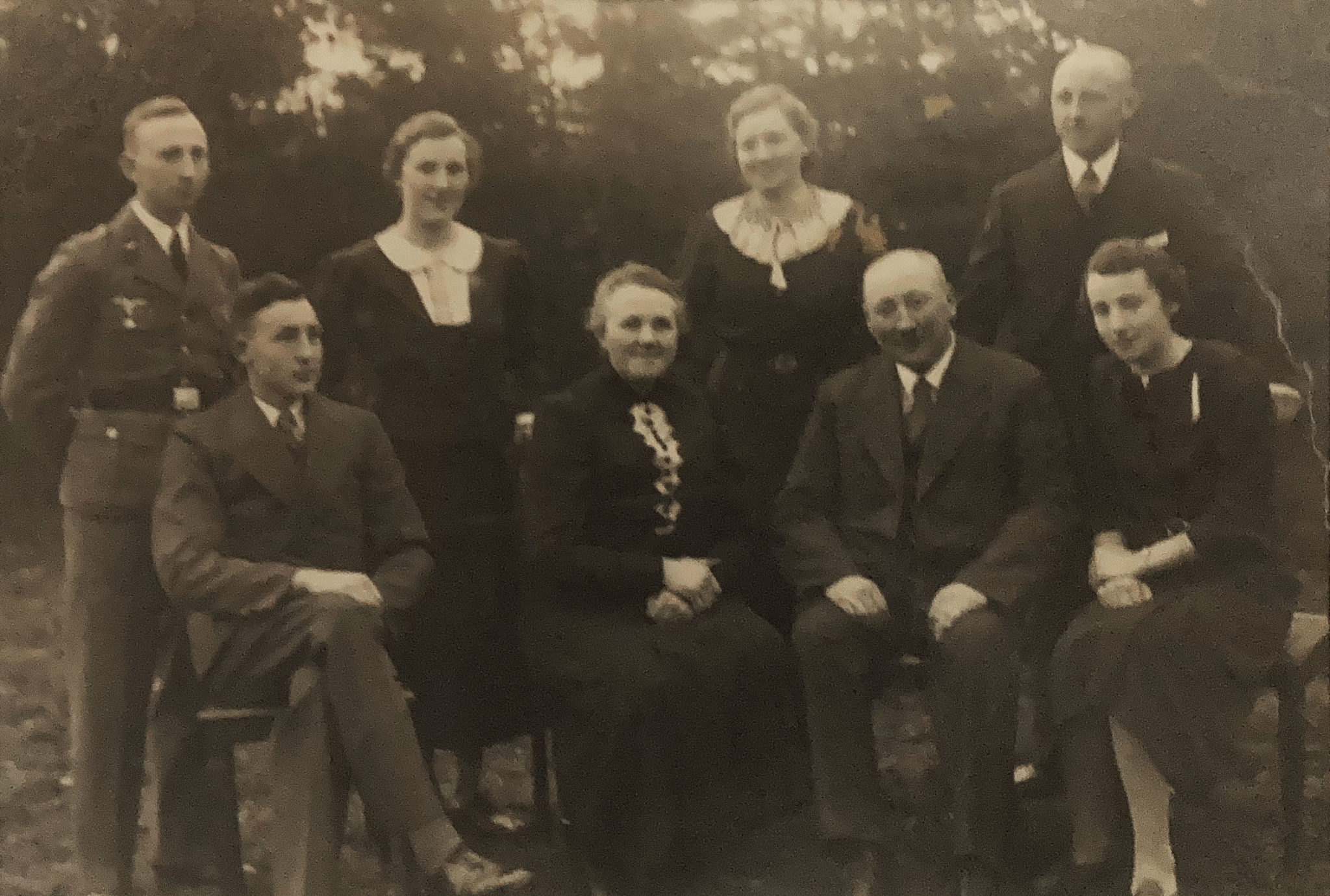
The family member also sent a photo of Clemens Brümmer (1887 – 1965) with his wife Maria (nee Shulte, 1882 – 1967) surrounded by their children.
Looking back at the journey
When I first set out to write a book about the Laker family in 2010, I wanted to provide a sense of the land my ancestors had left to come to America. I had a need to learn more about it, and I became curious if it would be possible to find the precise location of the Laker farm itself.
I reached out to various people near and far. Some were incredibly helpful and supportive, while others tended to dismiss my efforts and warned that locating a family farm in this part of Germany would be next to impossible. “They didn’t have address books back then — everyone already knew where everyone lived,” someone said. That may be true, but I knew that after Napoleon abolished the feudal system in the region, the common land was divided into private parcels. That meant it could also be taxed and sold, and there would have to have been a record detailing exactly where said land was. Otherwise, chaos would ensue. I just hadn’t been asking the right questions. Unfortunately, I stopped asking questions for a while, and that was a mistake.
After spending countless hours with my face buried in church records, I eventually became discouraged and walked away believing I would never find the family farm in Germany, not knowing that I was only about half of a mile off. When I returned with a rediscovered desire to find the answer more than a decade later, everything came together within the course of a few weeks.
Advice for researchers of German descent
My advice to anyone else who may be searching for their ancestral homeplace in Germany is to immerse yourself in it. If you are dedicated to finding the answer, leave no stone unturned. Often times the hardest part is “crossing the pond.”
Once you’ve located the family in their homeland, dig into the local church records and learn as much as you can about the family. Learn about the neighboring families as well. Study the history of the region. Use family tree maker software to keep your findings organized. Hire a bilingual researcher to help locate government records and translate them. Buy books to help you make sense of Gothic script. If your ancestors were Catholic, buy an ecclesiastical Latin dictionary too.
Search any relevant online databases you can find. Subscribe to Ancestry.com. Check out FamilySearch.org. And, holy cow, see if the church records are available on Matricula. Visit your local LDS Family History Center. Google combinations of names and dates and locations — you never know what you’ll turn up. Use Google Translate to not only read German, but to also convert English to German if you need to send correspondence. Write letters to people currently living in the community (and provide your email so they can write back). Write letters to churches. Be polite with salutations like “Sehr geehrte Damen und Herren” (Dear ladies and gentlemen) and the complimentary close “Mit freundlichen Grüßen” (with friendly greetings).
Document your research as you go. It will help you pick up where you left off should you need to take a break. Join online genealogy communities and ask questions. Ignore the naysayers. Devour every last detail. You will run into countless brick walls, but don’t be discouraged! If you need to step away for a while as I did, do it. I returned with a new set of eyes and a renewed determination to find my ancestral homeplace.
All of this just might lead you to your own perfect little pig farm an ocean away.
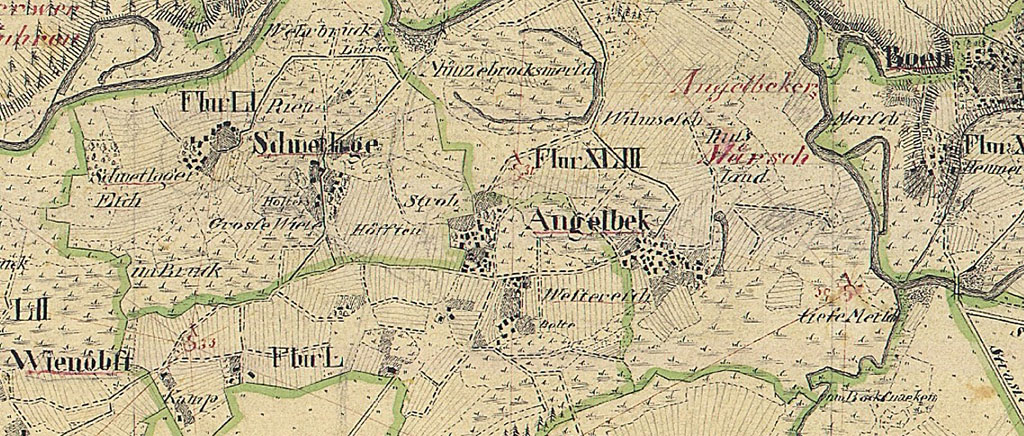
Absolutely incredible research Butch! Now I’m ready for the American Laker clan to head to Germany to stomp around our ancestral grounds and have a pint with the locals at the pub and learn more about this region. Congratulations on finding it!
Thanks Marc! That sounds like a great idea.